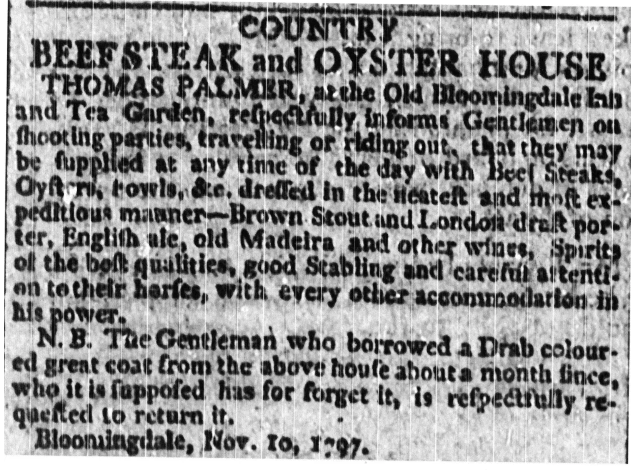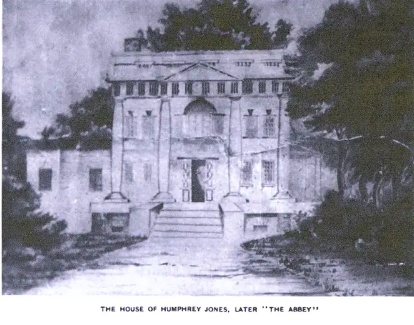|
This is the sixth post exploring colonial and post-Revolution Bloomingdale written by Pam Tice, Bloomingdale Neighborhood History Group Planning Committee member. New York City had a “tavern culture” starting in Colonial times. Taverns came in every shape and size and were owned by a range of residents, both elites and non-elites. The City profited from the licenses granted to tavernkeepers, issuing 314 in 1761. Taverns were male bastions where heavy eating, drinking and singing songs took place. Taverns provided a convenient place for politics and even government meetings. Horses and even slaves were advertised for sale through tavern owners. Fox hunts were organized by tavernkeepers in rural settings, like Bloomingdale. The tavern keepers and their taverns described here were found in newspaper articles from the time after the Revolutionary War to the early decades of the 19th Century. Benjamin Stout Benjamin Stout’s name first appeared in the 1790 census, listed next to/near Charles Apthorp and James Striker which clearly put him in the Bloomingdale neighborhood. He was next to Moses Oakley. Both men had slaves, four for Stout, two for Oakley. Who were they? My research found Benjamin Stout to be a tavern owner, but his tavern appeared to be one called the “Plow and Harrow at the Fresh Water” in the Out Ward, placing him in downtown Manhattan. He was licensed in 1758; an article in 1760 referred to him as a “noted tavern keeper.” In his essay on New York’s Loyalists, historian Christopher Minty, in writing about the Delancey family before the Revolution, mentions Mr. Stout’s tavern as one of the gathering places the Delanceys used to build their case for election to the New York State Assembly in 1768, when they tried to win against the Livingstons. I found a copy of Mr. Stout’s will, written in 1783 and “proved” in 1788, naming his oldest son as one of the Executors. Thus it appears that it was the younger Mr. Stout operating a tavern in Bloomingdale in 1790. An April 1791 Daily Advertiser (newspaper) article answered my question: “Benjamin Stout has opened a public house at the place belonging to James McEvers, where every kind of refreshment will be furnished to all who chuse (sic) to regale themselves at that inviting and truly pleasant summer retreat.” (McEvers was Apthorp’s brother-in-law who had died soon after he built his house in Bloomingdale; his property may have moved back to Apthorp ownership.) Moses Oakley Mr. Oakley appears in Bloomingdale’s federal census in 1790 and 1800 as a slave owner, but my research did not identify him as a property owner. Newspaper articles revealed that he was a tavernkeeper. In 1797, three articles told the story: in February, a “well known farm” of 53 acres was advertised for sale in Bloomingdale, noting that it was “now in possession of Mr. Oakley.” In April, a Thomas Palmer announced he would be opening “Bloomingdale Inn and Farm, lately occupied by Mr. Oakley.” In June, Moses Oakley advertised to his “friends and public” that he would be at “his new and pleasant situation” with a view of the Hudson River at the 5.5 mile-mark. However, by 1802, an advertisement, noting Mr. Oakley as an innkeeper, deceased, offered his “situation” the lease of a large two-story house with twelve rooms, one a handsome ballroom, a good cellar, dairy, kitchen, barn and other out-houses. There were sixteen years left on the lease. Another advertisement revealed the lease to be with Jacob Harsen, which explains the location first given at between five and six miles from the city, as that was where the Harsen property was located, and named “Harsenville” by some historians. What appears to be the same location—since Mr. Oakley is referenced—became the Shakespeare Inn in 1803, and the Pelican Inn in 1808 under the management of Mr. Becanon. In 1808, Mr. Becanon hosted a group of Masons, the New Jerusalem Lodge, who marched from the Inn to St. Michael’s Church, and back to the Inn for dinner, to celebrate the Festival of St. John the Baptist. In 1809, the innkeeper is named as Thomas Rogers, whose career in Blooomingdale is discussed below. Thomas Palmer Mr. Palmer appears to not have lasted long in Bloomingdale. After advertising his takeover of the Oakley site in April, he then advertised as “The Old Bloomingdale Inn and Tea Garden” in June, 1797, perhaps expanding his appeal to women who were out for an afternoon’s carriage ride. However, by November, the site, at six miles from the City, was a “Beefsteak and Oyster House,” as pictured below. (Remember, what looks like an “F” in this image is an “S.”) By January, 1798, Mr. Palmer was offering a lease of the site. In May, 1798, Mr. Daniel Mayer advertised that he would be running the Bloomingdale Inn and Tea Garden (occupied Lately by Mr. Palmer) and that he would be providing a “neat carriage and a good pair of horses” to bring his guests uptown. The carriage would leave Water Street near Peck Slip at 3 pm in the afternoon and return there at 7 pm in the evening. This was the only mention of Mr. Mayer. Thomas Rogers Thomas Rogers—not to be confused with the William Rogers who purchased property in Bloomingdale later—appears to be the operator of the “Old Bloomingdale Inn” after Mr. Palmer. In 1802, there was an advertisement for a gold watch lost at his tavern; in 1803, another advertisement called the place “the Old Bloomingdale Tavern” and located it at the 6-mile mark. Also in 1803, more details about the Inn emerged: that the house could accommodate eight to ten gentlemen who would pay $6 per week to have a single room, and $5 per week for a room with two single beds. In 1805 a guest there advertised for a “runaway Negro boy.” The use of the term “Old Bloomingdale Inn” suggests that this might be an old structure. I thought it might be the oldest of the two houses owned by the Humphrey and Nicholas Jones, in particular the Beverhoudt-built stone house sold to Humphrey Jones in 1752. By 1798, this site was owned by Robert Kemble; perhaps he leased one of the houses and occupied the other. Much later, in the mid-19th Century, this house became the Abbey Inn. In 1815, Thomas Rogers appears again, advertising that he is opening his old establishment, the “Bloomingdale Old Inn.” He “fancies his liquors and accommodations” will give general satisfaction to the gentlemen who “favor him with their company.” He notes in his advertisement, “No ladies admitted without gentlemen.” John S. Taylor In 1806, Mr. Taylor announced that he was giving up his grocery business in downtown New York and will move to Bloomingdale to the tavern “recently occupied by Mr. Rogers”. In January, Mr. Taylor posted the following advertisement: On November 11, 1807, Mr. Taylor posted the following advertisement:
John S. Taylor, at Bloomingdale, has a large full grown WILD FOX, which he proposes to let loose on Tuesday, the 17th inst. At 10 o’clock in the forenoon. Fifteen Couple of Hounds are already engaged, and it is supposed 18 couple will start the chace (sic) This wasn’t the only time an advertisement for a fox hunt was discovered in my newspaper research. In 1791, there was one advertised at Mrs. Day’s at the nine-mile stone. In 1805, one was advertised at Mr. Hunt’s tavern at the five-mile stone. Mr. Hunt’s Tavern, a bit south of our Bloomingdale neighborhood today, was also the site for Republican Electors to meet, in 1806 under the chairmanship of Mr. Valentine Nutter and another time under James Striker. In 1809 when Mr. Rogers was operating the Pelican Inn, he announced a fox hunt in November featuring two “beautiful foxes,” and the hounds of a Mr. Roberts, a noted sportsman of New Jersey. An excellent dinner would be provided after the hunt. Sources McPartland, Eugene P. “Colonial Taverns and Tavernkeepers of British New York City” New York Genealogical and Biographical Society Record Volume 103, Number 4 (October 1972) Minty, Christopher F. “Republicanism and the Public Good” New York History Volume 97, Number 1 (Winter 2016), pp 55-81. Newspaper articles at www.genealogybank.com and www.newspapers.com.
0 Comments
Leave a Reply. |




